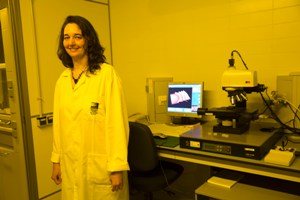Nov 6 2014
Since the 90s, femtosecond lasers have enabled the treatment of materials at nanoscale and microscale with high precision, but their production is still slow and expensive. Researchers at the GROC Optics Group at the Universitat Jaume I in Castelló, Spain, have developed an original parallel-processing technique that enables to multiply the production capacity of these lasers, thus improving their performance, reducing the time and cost of manufacturing and optimizing the use of laser energy.
The importance of this groundbreaking advance has led it to the cover of Optics & Photonics News, the disclosure magazine reference in its field, published by the Optical Society of America.
 Gladys Mínguez-Vega. Credit: Àlex Pérez
Gladys Mínguez-Vega. Credit: Àlex Pérez
Laser technology enables to process materials, i.e., to locally modify their properties with micron accuracy (one-hundredth the size of a hair) or even nanometre accuracy. This applies, for example, to the microchips or the stents implanted in the arterial system that are manufactured using laser technology, due to the demanding requirements of precision so that they work properly. Jesús Lancis, director of the GROC Optics Group, highlights that the progress achieved “will significantly improve the performance of this technology because it will enable to process the material simultaneously in several locations and, besides, without losing accuracy. Both facts are key to increase the production rate of laser technology, thus lowering manufacturing costs and allowing their gradual introduction into various sectors which used more traditional production mechanisms hitherto”.
The parallel processing technique developed by the UJI enables to split the beam into a series of multiple beams through what is called a “compensated dispersion module”. It has already proved its effectiveness to simultaneously generate 52 blind holes with less than 5 microns diameter on a stainless steel sample. “This research shows that we can increase production speed by a factor of 52, or even 100, without losing quality, with the change of system parameters”, explains the researcher at the GROC Group Gladys Mínguez-Vega.
The Horizon 2020 programme, which foresees the main challenges faced by science in Europe in the coming years, highlights the key role to be played by laser technology in improving certain processes for industrial production, particularly in those where the quality and finish of the piece are fundamental. Processing materials with light allows a high degree of automation and flexibility in industrial processes and the manufacture of components and products of exceptional quality, and in a much more sustainable way compared to other processing technologies. Laser technology is a clean technology in the sense that it minimizes the number of waste in manufacturing processes, but not only in the industrial manufacture: photonics also raises numerous advances in fields such as health, lighting and sustainability. “It is said that photonics will change our way of life in the twenty-first century, such as electronics did in the twentieth century”, states Lancis, highlighting the potential of this science.
A technology with endless possibilities
Laser technology was developed in the 80s of last century, but originally it consisted of continuous wave lasers that did not allow to work with microscale materials or to achieve a high level of quality. It was from the 90s when the pulsed femtosecond laser appeared, a laser operating with pulses programmed in extremely short time spaces, thus allowing light to accumulate in such a way that the energy charge that triggers when the beam is released is much more potent. This technology has provided a greater precision and quality, says Mínguez-Vega: "These lasers are being used, for example, in some surgical operations for less invasive, more localized and precise cuts, or in the development of micromachining in all types of materials, including the biodegradable ones. With so short exposure times and with such a high energetic charge, femtosecond lasers also prevent heat from spreading beyond the point to which it is addressed, even allowing their use for cutting explosives”.
The fact that energy is so concentrated causes that it has to be even softened. “If you spent all this energy, you will deposit so much energy that you would end up causing damage to the material. To avoid this, we use some filters that reduce light to the right energy”. The matrix developed by the UJI allows splitting the beam and multiplying the points of light while reducing the energy of each one of them. “Currently, for micromachining a piece with a femtosecond laser, we have to move the laser or the material to scan it, so production has to be performed point to point”. The matrix developed on UJI campus divides beams and keeps their effectiveness. This enables to micromachine dozens of different pieces at the same time, thus multiplying by hundred the speed of the system with the subsequent cost reduction.
The magazine published by the Optical Society of America, the most relevant optical society in the world, devotes its front page in its issue of May to the optical system for femtosecond lasers developed at the UJI. Through an extensive report on the latest advances in ultrafast pulsed lasers, the magazine notes the progress achieved by the GROC Optics Group at the UJI, which had been previously published in the journal Optics Express.